Mat Clayton bootstrapped Mixcloud over ten years with a total team of five to build an audio streaming business with 15,000,000 MAUs. Whilst convinced that if Mixcloud had taken early funding, the company took $11.5 million funding from a little known investor in 2018.
In this talk from BoS Europe 2019, Mat shares some of the things that helped him to create such an effective bootstrapped operation and how, after a decade, Mixcloud decided the time was right to find an investor who could bring value beyond cash to take the business forward.
You will leave with ideas you can use to get more from small teams, how you can use data to inform your product development decisions and some of the critical considerations you should consider when the time comes to find an investor that can bring value beyond capital.
Slides
Sketchnote
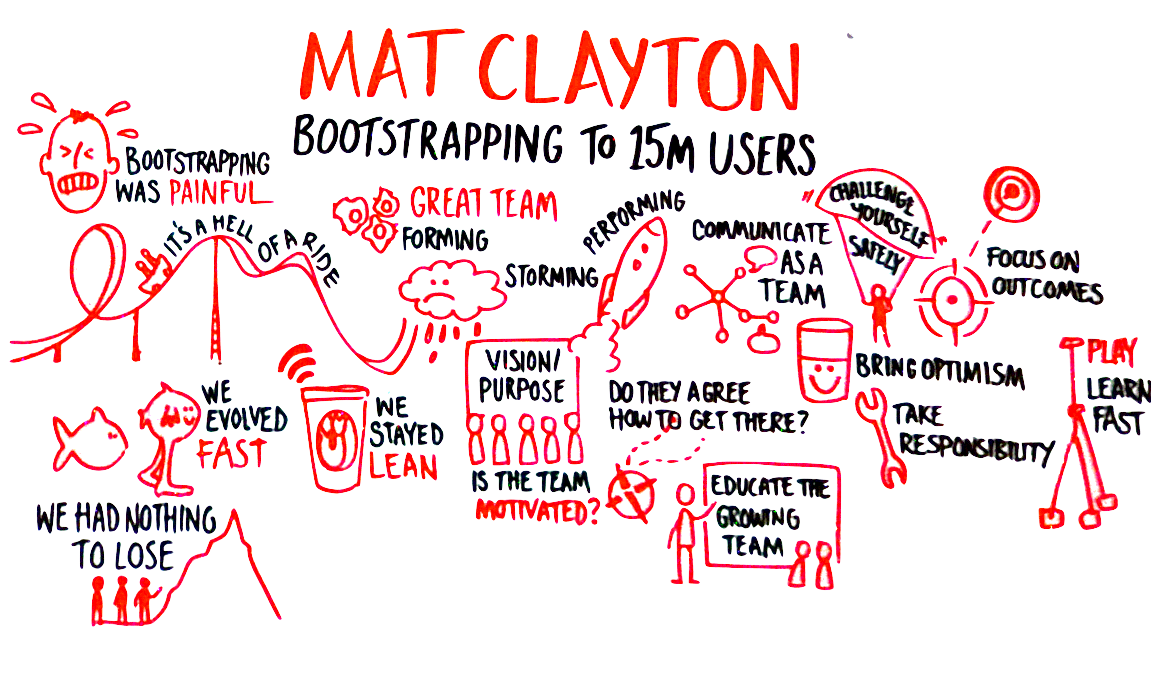
Transcript
I’m probably gonna have to start by explaining why that track was played. Mark knows. That’s because I didn’t reply to his email saying: “What track would you like to come on to?” So what Mark’s done is he’s gone to my Facebook profile and found the last test file I’d uploaded there and is putting that on instead.
What is Bootstrapping?
So what do we do? Or what do I do? Just to give you some context. So I run a company called Mixcloud, I’m essentially the head of product and CTO there. We bootstrapped it from zero to 20 million users. What we do as a company is we allow people to upload audio files, usually DJ shows, podcasts and mixtapes to our service, and other people come and listen to our music streaming platform. We now have about 50 million shows across DJs, podcasting, etc. This just gives you the context. But let’s move on to what we’re here to talk about. So I’m here to talk about bootstrapping. I found this wonderful description as I was preparing for this talk. Bootstrapping is defined as the minimalistic business culture approach to starting a company, which is characterized by extreme sparseness and simplicity. While it takes some time to think about this, this kind of reflects how us as a company have evolved and what we’ve done. And I think we’re in a very unique position, because firstly, we bootstrapped, which is not that unique. But if you look at bootstrap companies within music, it is super unique. So I’m gonna try to talk today a bit about what we’ve done and sort of reflect a bit on what we think worked, why it worked, and what didn’t work as well and sort of see if there’s any lessons there, which hopefully, you can relate to your companies.
Experience of Bootstrapping.
So bootstrapping, honestly, it was painful. And music is brutal at best, but I would do it all again in an instant. As Mark said, we bootstrapped for about nine years, we finally raised funding last year – that was a big sigh of relief. So why did we bootstrap a company when every single competitor, and I mean literally anybody successful, has 400 million plus in funding in this industry. Genuinely, it was naivety, stubbornness and blind belief that we might get somewhere. That’s the best I’ve got for why we did this. And why we continue to do it to be honest. However, what I haven’t said here is we tried to raise funding 5, 6, 7 times and I’ve been to the market so many times, it’s just become a farse to be honest. Every single VC this side of the Atlantic, the East Coast and the West Coast knows my first name at this point, and they will come to us time and time again, saying “We will invest in you guys. The moment you do something outside of music, stop doing music.” It was painful. Please don’t tweet that either. However, we finally found some media VCs. And we raised up a wonderful company called WonderCon in the US who have been fantastic, I couldn’t actually speak better of them. And I’m not saying that because they’re in the room, they’re not there in LA. They have been amazing. And I fundamentally believe that’s because every single one of them is an operator, not one of them is somebody who’s a finance person.
Why Did They Raise?
So I’ve said this to a few people in the audience today who have asked me why we finally raised. And there’s a few reasons. One of them is very deep into the business. So we needed to build a new product and get it into the market. And in our industry, you need to get licenses from major labels, copyright owners, etc. And you need a lot of capital to do that. I mean, several years worth of runway in the bank just to even get in the game. So we needed to do that. By the time you’re at that point, no bootstrap company keeps two years worth of runway in the bank, that’d be crazy. You’d invest that. So we had to go out and raise. However, what we did find is that they’ve actually delivered way more value to us than that, they bought ideas, they bought network. And honestly, they challenged us in ways we can’t challenge ourselves. They’ve operated companies on scale, I would say greater than anybody probably in this room, for example, one of them and Disney for the last 15-20 years, and founded DreamWorks. And that’s the kind of market intelligence we just can’t get. This kind of deep experience we can’t get and it’s also somebody who’s there for us on our site to say, look, this is okay, we’ll make it through. And I mean that genuinely, I’m not just saying this because they really won’t. So we’ve spent a lot of time reflecting ourselves, trying to figure out why we made it when literally hundreds of startups in music die, left, right and center.
We think there’s three principles as a company to do with how we operate, which is why we survived. So I’m gonna go through these today, they may work for you but this is what worked for us. And it’s not gonna work for everyone. But I think some of these core beliefs actually do work for a lot of companies. So as a company, we reflected, we think that iteration of evolution, and learning is a massive factor. We spend a lot of time trying to learn faster, I’ll go through these in more depth later, we’ve stayed lean, and we’ve optimized in ways that others just can’t, because we’ve been forced to because honestly, if we didn’t do that, we’d be bankrupt. Or we wouldn’t be able to afford the ramen noodles we were paying ourselves with. We had nothing to lose, we took bets others just wouldn’t take. So let’s go through these one at a time. I’ll try and fly through this and get through pretty quickly because I actually think this is just the tip of the iceberg, we need to go a little bit deeper. So how did we iterate or evolve faster than others? Today, we ship the product, which goes out to about 20 million people, roughly every 10 minutes. So I can tell you since being at this conference, today, we’ve probably done about 10 to 20 pushes in the last couple of hours, I just logged in to have a quick check. That includes mobile devices. So that includes iOS and Android. For those of you interested, I can talk to you about how we’ve technically achieved that. But we religiously focused on the speed of iteration. And we do that basically so we can learn. We believe that learning faster is the key, not the output, not even the outcomes, but the learning itself. Pope Sam Altman said this, and we believe this the core, to move at faster speed is one of your main advantages of the startup.
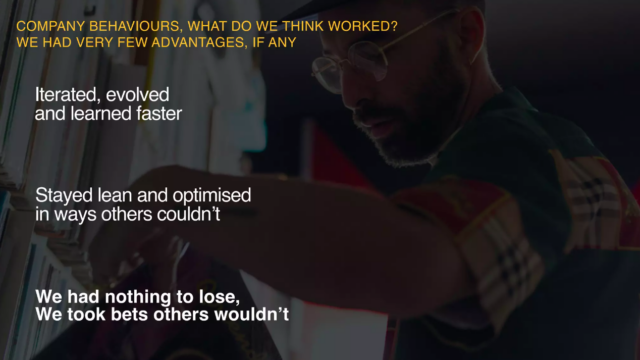
For us, this is key. For you, it might not be, maybe you’re in an enterprise, but this is one of the things where startups actually beat enterprises, they don’t have the resources. They certainly don’t have the personnel the money, they can’t just buy the competition. They have to learn faster. We stayed lean and optimized in ways that others couldn’t. So this slide is actually quite poignant. I’m not sure you can see this here. So can you see in the background as a warehouse? So when we first launched the company back in 2009, just around BoS time. My other co founders actually got paid to move and live in that warehouse, because we couldn’t afford rent. So we were literally broke, I think we had about 1000 pounds between the three of us in our bank account. So we did this in 2009. So about the time of the recession, all these warehouses in London were going empty. So we went round a few of them and said, “Do you mind paying us to live there and that way, squatters weren’t moving?” And they were like, “Yeah, sure. When do you want to stop.” So we had a 30,000 square foot warehouse from day one, around about six months, and we decided that wasn’t big enough and upgraded to a 60,000 square foot warehouse. Which is now the Amazon distribution hub, by the way for London. So the thing I love about this story is it just summarizes the lengths my co founders would go to, we didn’t have internet, and we were building an internet platform. Because we were living in a warehouse in 2009, before the iPhone was really invented, or anyone had one.
Starbucks as User Research.
So what we would do is we would go down to Starbucks, and we’d basically buy a coffee and ship the new version of the website there. And then, and at the same time we ship it, we’re gonna ask the guy to our left, who was sat on his laptop, usually to come have a look. And that was called user research. We still do this today. Today, I’ll go and give engineers Starbucks cards and say go and hand them out in Starbucks, just like go and find people to talk to them and ask them to go look at it works great. That one top tip, by the way, if you put a big arrow of Starbuck cards to you, pointing at you, people will come and ask you what’s going on. And the Starbucks staff are trained not to kick you out. This is another great example, I won’t get into it too much, because by the way, I’m an engineer through and through, but we essentially built our own version of s3, which is the big storage system. And when I look at our financials, day in day out, we will be bankrupt. If we hosted on the cloud at this point, we’re now operating around about 10% of the cost. Most people will have a like for like using AWS or GCP services, that’s Amazon or Google. And for us, this is a huge competitive advantage, we can now ship worldwide audio content more efficient, basically anybody else out there. We have nothing to lose. And again, sorry for the opacity here, but there’s a mountain range in the background. And this is sort of a story we’ve seen again and again. And not just us. And I would say we haven’t done this as much as other companies. But I have seen others do this again, multiple times. And it’s a nice anecdote.
Learn how great SaaS & software companies are run
We produce exceptional conferences & content that will help you build better products & companies.
Join our friendly list for event updates, ideas & inspiration.
So what happens is, you’re building a company, you essentially want to climb to the highest mountain, which is like the pinnacle of success, you get to the top, after months, years of struggling and you look around and you’re on the top of the mountain, you can see a bigger mountain in the distance. You have two choices at that point: climb down and go back up. The other one is to be happy where you are. As a company believe that we’re at the top of the mountain, but we’re here to build build the biggest best thing we can. So we need to go over there which is painful. We have to reverse a lot of the ways we’ve thought a lot of the products were built to get to that better world. For us this involves things really around product, but we use this analogy a lot internally. But as I say realistically, we’d do it three or four times in the history of the company, we’ve killed product lines, which we thought was detrimental. We’ve built products, which weren’t just meant for music. But then we were aiming at podcasting, which is a bigger market now. So think about your product lines. Enterprises fail at this historically, again, and again and again. But this is also one of those areas where you see, some of the tech giants really survive. And by this, I mean the likes of Facebook or Google, this is how they execute, they get to that top and say, okay, where next. You may agree or not agree with their methodologies, it works for the some of the key players. So these are the behaviors we want as a company. And when we think about how the company behaves, the company is made of people. And we really have to think about how the behaviors in individuals and the people within those companies are comprised and how they combined together to actually drive those behaviors. Because you can’t just say, as a company, we want to behave like this. It just doesn’t work. I mean, leadership and management have to do that. But it’s really the tip of the iceberg.
Team Formation.
So let’s talk about people. Let’s talk about how you build high performing teams, because that’s what we think is key. We got to multiple millions of users per person, per engineer. And we think that that’s because the team was hyper performing. I say, because we actually think we no longer are. And we think we have to think about this and find ways to fix it. This next sort of five to 10 slides was given to my team, maybe a month ago now to say, look, we need to reflect, we need to figure out what’s gone wrong the last year, and how we fix it.
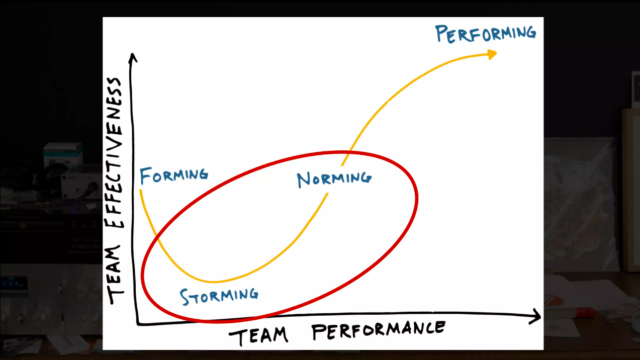
So I’m gonna start by talking about some of these behaviors. But before that, let’s go about some of the principles of high performing teams. And you’ll see these online, you’ll see people talking about this, but let’s just quickly go through it. So there’s four stages to a team forming, which is like the team gets together storming, which is the bad times norming and performing. And honestly, we’re here, most teams are here, they formed, they sort of expand a bit. And then they bounce around before between storming and norming. Again, and again. And again, never really getting to a place where it’s utopia, and everything is just working. And it’s hard to look at this stuff and say, We’re not a high performance team. Like it’s hard, but you need to and I would say if you look at the audience here, how many of you would put your hand up and say our team is outperforming, we can do no better? Anyone? Okay, no one. Like, we need to reflect on this stuff. So let’s, let’s go through the definition. So we say a team is forming. And again, this is a well understood public thing. We didn’t come up with this, but it’s just how we reflect on it. There’s that excitement, you’re starting, it’s the beginning of something and the team is just gelling. And actually, at this point, they generally perform pretty well, because there’s so much excitement, but there’s not many people. So it goes okay. Then you move into the next stage. What’s going on, there’s lack of processes, the roles are conflicted. People are fighting, there’s politics going on. This is where the product might be successful with other teams. Norming, you kind of get over that you accept each other’s differences, appreciation of colleagues strengths, you’re like, okay, this person is good. Eventually, feedback comes in. And then you start progressing towards your goals, not as individuals who have heroically dragged a project over a line, but as a team. But actually, there’s a step further. The step is like when goals are achieved without friction, things just happen. Things just flow. Once you’ve been in the team, which works like this, you’ll recognize it again. And again. And again, until you’re there you won’t, you’ll just be like this is normal. And that’s the point of it being norming versus performing. People join and leave with no single point of failure. It feels natural, and people want to stay there. And the nice thing we find about this is the say we have popped up into this occasionally, is that people are happy at work as well. Like it just becomes content. There’s another way of explaining it. So let’s try and figure out what behaviors sort of go into this and break it down a bit. And I’ve kind of got six behaviors you’d want to see from your team to really hit this but forgets those. Let’s go through like a couple of quick checks. Is your team talented? Like it’s a really hard question to ask. But often people are super talented. So the guy in this picture is a guy called Alex Honnold, who is probably the best climber in the world. He just did the free solo film, which I’m sure most of you will be aware of, because it just won an Oscar. But this is actually a moment where he’s climbing Half Dome without a rope. Just put this into context, and has a complete panic. He’s just like, why am I doing this? I’m not capable of this. He just breaks down. And there’s a video of him walking out there just having a moment on his own. I think this is about 700 meters up at this point. Because, some context, El Capitan is 900 meters and he’s nearly at the top having done one of the hardest climbs in the world. And I’m a rock climber by the way, so I can appreciate how shit scary this is. But every member of your team will have something go on outside of work. It might be a personal disaster. It could be anything communicating with them. And figuring that out is often actually to be honestly 50% of the problem. And just ask them, how’s it going? It’s really basic. Is a big divide between other talent or is it just not working right now for them. And then I’m sure this has come up before.
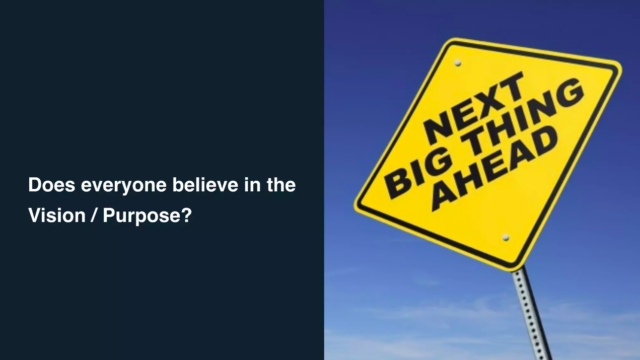
But we look at things like purpose, mission and vision a lot. And we’ve, we’ve evolved this a lot over the years. And this is where we settled that about three weeks ago, we have a purpose, which is the reason we exist, we have a mission, which is what we will accomplish in the next couple of years. And then we have a vision, which is what do we want the future to look like. And for us, these are quite simple. So I’ve just laid them out there. But our purpose is to amplify culture through audio, we’re an audio platform. Our mission right now is to enable 100,000 audio creators to take control and meaningfully monetize their communities of fans. And we choose these words very carefully. We already have 20 million users, but we’re not bothered about that, or we want to actually do is take 100,000 of those people, creating content, and meaning be meaningful to their lives in a monetary sense, vision, a world where anybody can listen deeply, create sustainably and connect passionately. Ultimately, you will never complete that purpose. Hopefully, that mission should be completed in about 5 to 10 years. And that vision, maybe in 20 years, it’s hard. These things are meant to be hard. They’re not meant to change apart from that mission when you complete it. We heard yesterday about putting a man on the moon gives you a very concrete way of thinking about a mission. And there’s a lot smarter people than I have. I’ve talked about this at length, as I say, I’m an engineer, I’m not a person who normally focus on this stuff. But let’s talk about alignment against these and how we think about people. So does everyone believe in the vision of purpose, I often hear engineering managers say everyone needs to believe in this stuff. The reality is they don’t, we need them to be motivated. And I would say that the things I’m going to say on here are focused on the idea of: if somebody is not performing, if they’re not aligned with the mission, use these as a way to think through and work through ways of maybe aligning them, maybe not. So for me, like one of the things which drives me and brings me to work is actually I want to build a service, which is hard to build and challenged by technical things and has huge impact on the world. That could be an audio, could not be, which is weird to say as a founder of an audio service. But it’s true. And not every single person in your in your business has to be motivated by the vision or purpose. But it damn well helps. The mission? What is the company trying to achieve right now? Simple as that. We’ve heard about putting people on the moon. Like does everybody believe in it? Just ask that question. Just ask them: Do they believe in leadership and what we’re trying to achieve? Or is it too far out of their reach that they’ve just given up on it? We’ve seen this time and time again, where we put a mission out there, which is so lofty, and we’ve not had the conviction or they’ve not had the belief in us that we can hit it. And that’s a huge problem. It’s not easy. I can’t bring to a quick fix that for this. It’s very hard. But you have to get that mission just right. So if people feel it’s believable, but it’s not unattainable. Finally is, do they agree how to execute on the mission, we’ve really struggled with this. Because what it turns out is if you get a load of bright people, like 15-20 of them in a room and say we’re going to put a man on the moon, for the sake of argument, they’ll come up with 15 different ways of doing it. And what we typically found is that misalignment there, where they agree with what you’re trying to achieve, but they all disagree slightly. So what we find is that the point pulling in slightly different directions. And me as a manager, as a leader in the company, my job is to try and align everyone and say, Look, we have these 15 different ways but this is the one we think is best. And that might have come from the team, it might come from management, it comes from all over the place to be honest, in our case, but what we need to do is get down from 15, boil it down to one. So we are hitting that one because us hitting one of them 100% is better than 15 of them 10%.
Behaviours.
So let’s talk about behaviors. So we want our engineers and not just our engineers, our entire organization to behave in a certain way. I keep mentioning the word engineers, because that’s the team I work with most right now. And we believe that behaviors and how people behave actually drives the team output more than anything. And what you want to do is when you get these behaviors, right, and you find it flowing, and I don’t mean individual level, I mean at a team level, is that one plus one really does equal three. So the six behaviors we think are key, and I’m going to talk you through them, I’m going to try and suggest how you can get these behaviors out of people. But honestly, it’s very, very hard. And sometimes you’ll have success, and sometimes you won’t, it just won’t work. And you’ll need to find different ways to attack it.
Communicating as a Team.
So the first one is learn to communicate as a team, not as a group of individuals. We see people trying to talk the whole time, but actually are they talking the same language. And one of the first things we did about a year and a half ago is try and break down that definition of communication and come up with a common language between everyone. So the book mentioned at this conference probably about half a dozen times right now, which is a book called Radical Candor by Kim Scott, I would highly recommend what you do is take one of your teams or the entire management org is what we did. And say we’re gonna do a book club around this. We’re just going to give everyone a copy, we’re going to buy it, we’re going to ship it to them wherever they are in the world. And so you need to read it by this day or read the first half. The second half, by the way, in this book generally repeats the first half, but it’s worth reading still. So what we did is we sat down, we said, like, Okay, we’re gonna have a lesson where we all sit together, and we try and figure out how to talk to each other. And honestly, if you take anything away from this talk, that’s the most important thing is finding out how your team talk to each other. And whether it’s on a team level, organization level, it doesn’t matter, it cascades down. So we took the entire management team initially and said, anybody else wants to join us, you’re more than welcome. And we quickly had a book club with about 40 people in it. And on top of this, the one other thing we look at is trust, like, how do you trust your colleagues? There’s a great talk, which I’m not going to do justice right now. But we’ll reference by Francis Frei’s TED talk, it’s about 15 minutes long, go watch it. But essentially, the essence is, is trust is made made of three things, authenticity, logic, and empathy. The crux is if you don’t want to watch the 15 Minute Talk, it is focused on empathy, people have to feel that I’m listening to them, and they’re being understood. So you need to get to that logic and authenticity often flow straight from that.
Challenge Yourself, Safely.
Second, is challenge yourself safely. Pick up work, which makes you feel uncomfortable, you want your staff to push themselves, you can put barriers and you put objectives in front of them and say, Please go and hit this. And if they didn’t believe it, they wouldn’t do it, you want them to challenge themselves. It’s really hard to encourage that. And, honestly, the way we found it is suggested to them, wait until they do it, and then praise them for it. And just congratulate them, we have a channel a Slack channel. That is because the entire company called queued us, as soon as somebody pushes themselves will, will send it in there and your entire company will rally behind it and say well done, once they see the comrades or their fellow workers seeing this that other people start picking it up. And the behavior just escalates really rapidly. In fact, the Slack channel thing we do for all of these behaviors. Encourage people to engage in challenging discussions. So our team is currently debating about how to do translation, I can tell you now, I walked out of this auditorium this morning, there was like 500 comments on that. going everywhere. It’s one of the most fierce debates about actually very random topic I’ve seen in a while. But get people to engage in those conversations, like get them to actually step in. And one of the things we work on a lot is, I want to say diversity is buzzword bingo here, right? But one of the things we focus on in diversity is introvert versus extrovert, how do you think about those different personalities and how they interact with each other. And a lot of engineers are introverts, most of my team are tend to be extroverts, actually, but we think about these different personalities and think about how you get those introverts to engage in these types of conversations. People never grow unless you’ve managed to achieve this, they just won’t, unless they’re trying new things they won’t gather.
Bring Optimism and Enthusiasm.
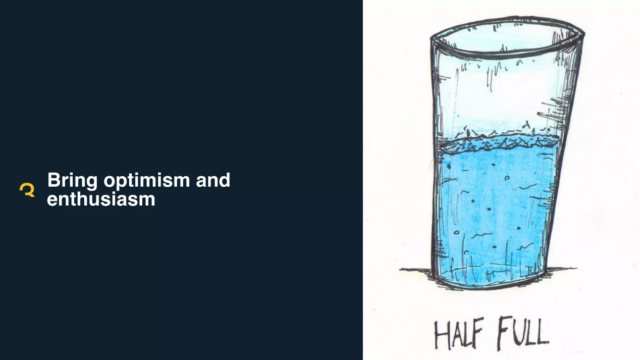
A lot of this is really obvious. So bring optimism and enthusiasm, get people to meetings who are positive. The way we tell people to do this is like, there’s two tricks we use, provide solutions to other people’s problems, stop giving them problems. When people two people are having a hard debate, and sort of person A cares about something, person B cares about something else, we’ll just stop the debate will like stop it. Like we’re going to end this now. Now you’re going to argue his point, and he’s going to argue your point, just swap over. And you’d be amazed how quickly having done that a dozen times with the team. And they all feel a bit awkward when they now have to argue for something they don’t believe in, they suddenly see the other person’s point of view. And at that point, when they start seeing other people’s point of view, they start talking about optimism. The other thing with this, and this is one of the hardest things, one of the things I have to do as a manager and a leader the whole time is start from the place of possibility, not impossibility. Start by saying how do we achieve this not we can’t do that. And once you start doing that, you then have to ask your team like, assume we can do this.
Let’s work backwards. So one of the exercises we often do is called Merlin, where you essentially look back from the future on yourself. So you say in three years time we want to achieve x. So the idea with Merlin for mythologies, he could go into the future and look backwards. So we go forward three years in the future. What do we have to achieve by them? In this case, let’s say we want 100,000 people making money off the service. So we start there, okay, we want that. That’s why I’m back six months. So two and a half years out, if we want to hit that big goal. Well, we know. So we want that 50,000 people, we need to have X, Y and Zed products in the market, keep rolling back month after month, quarter after quarter and build your roadmap backwards. And that starts from the idea we can build this crazy thing. And then brings it all the way back to today and where everyone just usually goes our shit we need to get started. It literally compresses it down into a panic moment. But it does focus the mind. Relentlessly focus on outcomes, not output process or perfection. Think about outcomes. And that by that I mean, what did you actually achieve like what was the deliverable to your user to the listener whoever is engaging, nobody cares if the you save 10% Here or there for something nobody observes.
So Warren Buffett, I think, hit this perfectly, which is why I put a picture of him up there. And there’s a great anecdote he tells him, we’re talking to you now. So his pilot apparently asked him, he’d been hugely successful in life, what’s, what’s the secret, and the response he gave back was write down the 20 things you want to achieve this year. So the pilot writes down the 20, things he wants to achieve. And then he said, Okay, take your list of 20 circle your five most important things you want to achieve this year. So he circles five of them. He’s like, Okay, now split your list and to five things on the left, you want to you really want to achieve 15 things on the right. Now let’s label on this huge to do list this is your do not do under any circumstances list. And for us, this hits home, because when you build a product, or you’re iterating, on something, there’s an infinite number of things you could do. And actually, the things listed from number five to 20 are your biggest distractions, because they’re the things you get tempted into doing, which actually prevent you from doing five things really well. What would you prefer to have done five things completed or 20, things partially completed, particularly when their numbers 15 to 20, said, I’d say focus on this, get your team’s to write it down and separate them out and get them to admit they’re not going to do those things. Good luck with that, by the way, they won’t do it, they’ll get distracted by it. But then you can go and hold it up. I’m actually about at the point where I’m going to pin this to the wall in our office of things not to do. And we’ll see how that goes, I’ll let you know in a future talk maybe.
Want more of these insightful talks?
At BoS we run events and publish highly-valued content for anyone building, running, or scaling a SaaS or software business.
Sign up for a weekly dose of latest actionable and useful content.
Unsubscribe any time. We will never sell your email address. It is yours.
One I have put down in my notes is focus on people who work to outcomes, not nine to five. And that’s a really hard one to take some companies, you want people who, you know, work their hours, you don’t want to push them too much. You care about coaches, and other people, other companies like us, I want people to think about their results and their outcomes. I don’t want people on the clock, if you get your job done by three, I’m fine with that. We’re good. If we need to ship tonight at 6pm, as we often do, because we’re aiming for the US market. I need someone who’s willing to be there as well. And again, some people will love and hate this, it will be hugely divided. But think about what culture you’re building. Are you building something where you want people to work to the outcome? Or are you building a company where you want people to be happy, then work nine to five. And sometimes these things explain sometimes you have to pull them apart, it’s hard to do. You want people who will pick up more, you want people to take on more things without being asked too soon as you get people into that behavior. Again, we start seeing massive outcomes. And for us, the way we drive that is again, we congratulate them when we do it, they do it. We’ve seen people literally build an iOS app from scratch or TV OS app from scratch. So we’ve released on Apple TV, because one of the engineers just decided to do it. About a month later walked into the Apple Store and founders ranked between Bible and lad Bible, which was one of the highlights of my life. I’m not sure what that says about the company to be honest. But I do like it. Anyway, the the methodology and the way we think about this is a quote by General George S. Patton, who’s a US General. And honestly, there’s an awful lot of great quotes by him. He’s a goldmine for this kind of stuff. But this perfectly sums up how I think the team should execute. So a good plan violently executed today is better than a perfect plan tomorrow. What this means is, don’t wait for perfection, just do it, just get on with it and learn that way.
Take Responsibility.
Finally, take responsibility, like own your fuck ups publicly, as a manager as an individual. And at that point, we can learn from them, and we can talk about them. Like it’s okay to fail. And that’s a really easy thing for me to be here and say, it’s a much harder thing to do in public. And I think Facebook actually nailed this for once of a better quote, but they put these posters up around around the office, which is nothing Facebook is somebody else’s problem. And I think that a lot of us have something to learn from this is like, we’re here, and we’re in it together as a company. Like, if something goes wrong, I’m not going to pass blame to somebody else, I want someone who’s gonna go over there and try and fix it. And we want that behavior through and through in our staff. So if something’s broken, just get on with it. So there was a great example the other other month we moved offices about three months ago. And because we moved offices, it’s a little crafty around the edges, like the TV’s not up on the wall. The whiteboards aren’t erected. The hat stands aren’t there. And I can tell you what, what happened when I went into the office. It wasn’t the the office manager is putting up the hat stands. It was to the other founders, when asked why they’re like I’m doing this to other people. No, it’s not. It’s no one else’s job. We just need to get this stuff done. It doesn’t matter who does it. Just get in there and get it done.
Speed of Learning.
And finally, probably the most important things we’ve learned is, and I’ve said this multiple times throughout this talk is focused on the speed of learning. Like it doesn’t matter what you do and generate as an output. What really matters is how much your team has learned because that’s a prediction of how well they will behave and what outcomes will have in the future. So the key to this one we find is like when we do retros. It’s like, Don’t ask what went wrong? Like we do that, obviously, we tend to ask what have you learned, though, we flip it into a positive. And that way we write down learnings and we spread them across the company was challenging people about what they thought was true, which is and what now is true in the world. So focus on that think about it that way. We’ve demonstrated this to the team in an off site last week, and this is a photo from it. So have you all heard about the marshmallow challenge or marshmallow spaghetti challenge? Yes, no, essentially give people a load of spaghetti and a marshmallow and say, build the highest freestanding structure you can manage. So we did this with the team. This is jati, who built this one on the right. And we basically say you’ve got five minutes to get on with this. And what you see time and time again, is kids and no late adults at this age, because adults sit there and they plan. And they figure out this perfect triangular structure, and they build something. And at the last minute, they let go of it and it falls over horrifically. Particularly we give them the challenge of the marshmallow has to be on the top. Kids, however, just play, they start sticking it together, it looks ugly as hell. But it usually is sort of bringing around and we’ll stay up for about 30 seconds longer than the timer. But usually what you find these kids when it’s because they play and they learn as they’re playing. And why is business different or certainly why on products different in our world, we launch and we iterate and we learn. And we do this by doing things we learn by doing not by talking about doing. So we see this a lot, right.
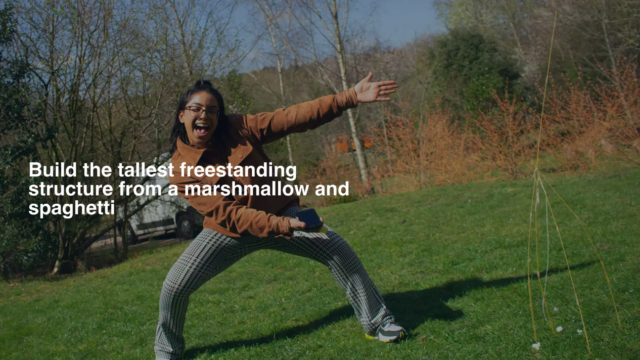
And then I’ll end with this thought on learning. And I don’t quite know where this quote came from in trying to find it. But it’s one which has been floating around out here for a while, we need to start making new mistakes. We can’t keep rehashing old ones. Because ultimately we’re here to learn. And if we keep making the same mistake again and again, and again, we’re never going to deliver a higher or better product, we’re going to end up plateauing where we are. So what we need to do as a company and actually as a field is start making new problem mistakes. So finally, if you build these six behaviors into your business, into your team, I believe your team will perform better and ultimately your business will have a better chance of success. Hopefully this is useful for you. I don’t know, this is where we’re reflecting on right now what we believe is what’s been core to our success and where we actually need to go and do some deep thinking and think about how we approve stepping to the next stage of life to be honest as a company. Thanks for listening.
Fantastic, let’s get a few questions. And the quicker we get the questions, the quicker we get the answers.
Want more of these insightful talks?
At BoS we run events and publish highly-valued content for anyone building, running, or scaling a SaaS or software business.
Sign up for a weekly dose of latest actionable and useful content.
Unsubscribe any time. We will never sell your email address. It is yours.
Question from Audience: Hi, thank you for a very interesting talk. My question is around bootstrap companies usually being very scrappy in the way they use resources. And then suddenly you have 20 million. Did anything change for you? How did you make sure you didn’t spend it all in one day? And what needed to change in your culture to sort of be able to see it as okay to spend money? And how do you track outcomes as a result?
It’s a great question. There’s a lot of facets to that. So we are very much drilling home: it’s not okay to just spend money for the sake of it. But we were finding that the biggest culture shock we’ve had, as we’ve added a lot of people, how do we educate them and how we operate and what’s true to us. That’s hard. That’s really hard. So that’s been the biggest challenge is hiring people. That’s its own problem in itself. But let’s assume you’ve solved the problem of getting great people, then educating them that: it’s not okay to do that. We want you to go make mistakes, we want you to push the boundaries, and we don’t want you to just splash cash at problems. That’s actually honestly one of the areas where we are micromanaging it. We’re trying to educate this team over the next year or so and saying: that’s okay, that’s not. We’re drawing it out to the individuals, we’re not putting it on public who just like this is how we behave. This is what’s true to us. And this, honestly, in our industry, in music, the margins are thin, we need to be lean, we really need to be. Yeah, things have changed a bunch. But actually, we’re trying to stay true to our core. And that’s what I’m talking about by we’re reflecting a lot of trying to think, how do we we get back there? And how do we educate the new people coming in? And that’s some of the processes we’re putting in places like celebrate that stuff when people do stuff we believe is in our values and how we want to behave? Obviously, we have spent more money than we would have done previously, but I don’t think we’ll get back up just yet.
Question from Audience: I have a very similar question, but I’d like to change it slightly. Now, now that you’ve essentially got this money, it was the reason you’ve now taking the money essentially, as Jason freed said to sort of take risk off the table or have you actually gone: this is a major change in how we’re going to run the company.
A bit of both, to be honest, so please don’t tweet this answer. So we raise money because we’re, we had to change our licensing deals. So we’re doing radio licenses. So we changed the direct licensing model. To do that the structure then was very different, which means we needed about two years worth of working capital in the bank, if not more, so by the time we raise that much metal raise a whole load more. And we wanted to do that change of licensing deal specifically, because of the way in the market is shifted. We believe that offline and ad free are two big things people would pay for subscription business. So we’re essentially product driven into that change. So we saw where the market was shifting, we saw where the product was going to achieve that we needed to unlock extra capital, we could have waited five years and probably being blown out of the market by everyone else. So we raised the capital.
Question from Audience: And did you pocket some money as well, at the same time?
Not very much. Let’s put it that way. Not enough to buy a house.
Question from Audience: To what extent and in what ways did you find that being bootstrapped actually constrained your learning speed and your iteration speed?
It’s a great question. And probably, there’s certain areas like as I say, we built our own hosting systems, for example, where we could have bought off the shelf. For us now it’s a great advantage. But back then we spent a lot of time energy, and probably money as well, learning how to do that, but not as much as we would have spent elsewhere. So there are definitely areas where we had not invented something because we weren’t willing to pay for something. Thankfully, a lot of that stuff is fairly foundational. And it’s in place and works now, though, don’t just mean things like hosting, but lots of technical areas, like email sending as well. And there it is the biggest restriction, not staff and not the mentality.
Question from Audience: I just wanted to hear a little bit more about when you said that you you did your own version of s3. Yeah. And it was it was more cost effective? Does it introduce some risk to you from like, a continuity point of view? You’re still committed to that?
Yeah. I mean, I have Amazon and Google account managers phoning me about every six months at this point to swap. We’re not going to change from that. Two reasons, is mainly bandwidth, actually, to be honest. So we have two times 100 gigabit links, and we run at about 50 to 100 gig on each of those at times. Getting that through Google and through Amazon will cost you best part of a couple of million quid a month. We’ll do that for about five grand.
Question from Audience: Can you sell that to others?
Would we sell it to other people? No, it’s peering arrangements, essentially. So we’ve done deals with a lot of the the other networks in the UK and also worldwide. So links, for example, London Internet Exchange, people like that. So you’re buying a socket and a connection, you can kind of do this through Google, but in Amazon, but not easily. But to get the bandwidth you need the content stored, where you want the bandwidth to come from. So by that point, we had to build the storage systems.
Question from Audience: Thanks for your talk. A couple things. I feel like there’s a tension between a couple things you said and that I feel on our team? Of course, one was, if you can get your job done by three, go home, right. The other is, we want to reward folks who take on new projects, and there’s nothing that isn’t your job. I feel that a company has grown really fast to like, how do you both balance like creating that place where folks feel okay, being done at the end of the day, while also rewarding folks who will take on more and more?
Yeah. It’s really hard. Honestly, I wouldn’t say I have a definitive answer for you. It’s just it’s always in turmoil. Right? We do other things as well, like we saw mentioned earlier, the unlimited holiday policies, we have one of those take off what you need. And I’ve personally been running the stats on how much people holiday, people take usually 25 to 31 days on average. So we kind of reword it and a lot of it is actually what we found is it’s not about what you have people behave, it’s about how they believe they can behave, they feel like they have this freedom to take holiday whenever they want. Therefore, they feel more liberated because of it. When we look at the numbers, they take about the same number of days. Not across all circumstances. So we’ve had to drill in on some people and when we’ve noticed of them undertaking holiday and sort of expressed they should take more. Actually when we did that we realized that there was a direct correlation between founder and lack of holiday.
Question from Audience: So that’s the question is how many holidays did the founders have last year?
About nine to 15 depending on which one.
Mark Littlewood: Lead by example, young man,
I was the worst case by the way. Yeah, because I don’t like paperwork so I haven’t filled in the forms. Not sure.
Mark Littlewood: True founders advantage.
Yeah, it is. So yeah, sorry, I don’t have a definitive answer, though. It’s really hard. Generally what we’re finding is once people are motivated, if they’ve done it through, they pick up something else because they want to do it and they love it. Like, yeah, when it all flows, it goes that way. Not always.
Mark Littlewood: Have you got a question for them? We’ll do that A and Q thing.
I did have one earlier, but it’s kind of my mind now. Would you bootstrap a company if we were fundraised? If you’d raise funding today? Would you would you bootstrap a company now having heard this?
Well, great question. Show of hands. So that’s: you would bootstrap a company having heard that having bootstrapped company for 10 years, would you then take funding as another question? Do you think that’s given you a lot more options just in terms of where you can go by bootstrapping for quite some time?
Yeah, I was gonna say once you’ve taken the money, you can’t give it in them back.
Matt Littlewood: Well, you could. Okay, I think let’s say thank you very much indeed to Mat.

Mat Clayton
Mat is a co-founder of Mixcloud and as CTO, he heads up the technical development of the site and shares the CEO duties with his co-founders.
Before Mixcloud, Mat worked on a variety of systems and control projects, ranging from biometric monitoring for Electronic Arts to Zigbee based wireless data capture systems for the oil industry and developed a range of successful Facebook applications, including Sponsor Me, and Become Rambo – was awarded best Viral Application by the Facebook Developer Garage London.
In his spare time, Mat enjoys playing squash, rock climbing and motor biking.
Next Events


6-8 October | Raleigh, NC
Grab Tickets Now

13-14 April | Cambridge, UK
Grab Early Bird TicketsWant more of these insightful talks?
At BoS we run events and publish highly-valued content for anyone building, running, or scaling a SaaS or software business.
Sign up for a weekly dose of latest actionable and useful content.
Unsubscribe any time. We will never sell your email address. It is yours.